Cyber-Physical Security in a Substation
安全标准英文
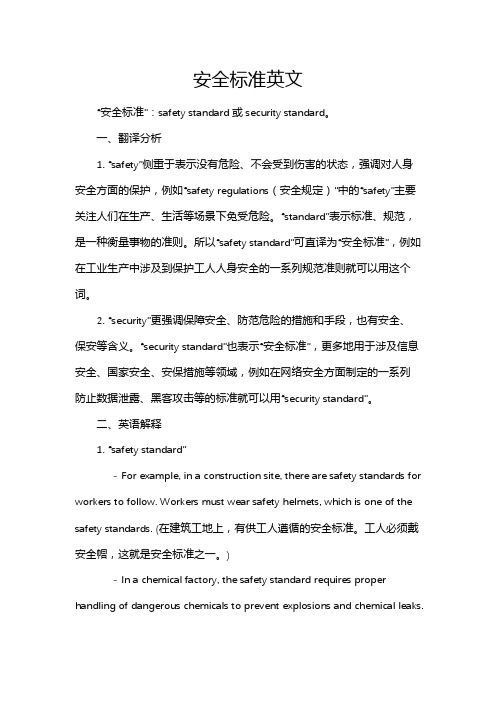
安全标准英文“安全标准”:safety standard或security standard。
一、翻译分析1. “safety”侧重于表示没有危险、不会受到伤害的状态,强调对人身安全方面的保护,例如“safety regulations(安全规定)”中的“safety”主要关注人们在生产、生活等场景下免受危险。
“standard”表示标准、规范,是一种衡量事物的准则。
所以“safety standard”可直译为“安全标准”,例如在工业生产中涉及到保护工人人身安全的一系列规范准则就可以用这个词。
2. “security”更强调保障安全、防范危险的措施和手段,也有安全、保安等含义。
“security standard”也表示“安全标准”,更多地用于涉及信息安全、国家安全、安保措施等领域,例如在网络安全方面制定的一系列防止数据泄露、黑客攻击等的标准就可以用“security standard”。
二、英语解释1. “safety standard”- For example, in a construction site, there are safety standards for workers to follow. Workers must wear safety helmets, which is one of the safety standards. (在建筑工地上,有供工人遵循的安全标准。
工人必须戴安全帽,这就是安全标准之一。
)- In a chemical factory, the safety standard requires proper handling of dangerous chemicals to prevent explosions and chemical leaks.(在化工厂,安全标准要求正确处理危险化学品以防止爆炸和化学品泄漏。
)- In a school laboratory, the safety standard demands that students should wear goggles when doing some experiments to protect their eyes. (在学校实验室,安全标准要求学生在做某些实验时要戴护目镜以保护眼睛。
Cybersecurity Protecting Digital Assets
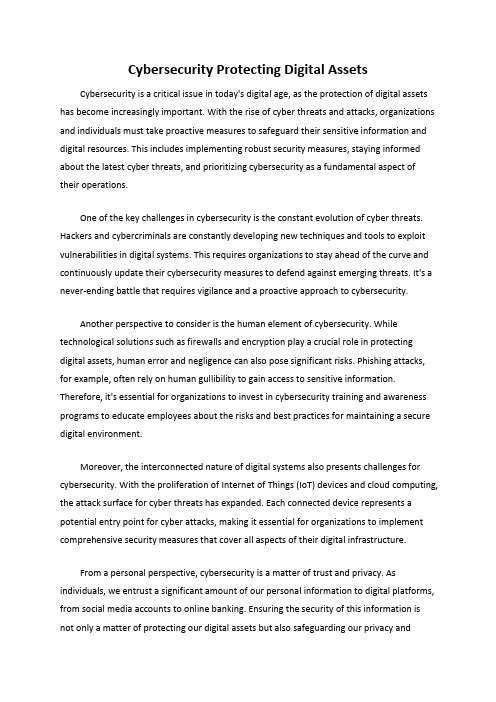
Cybersecurity Protecting Digital Assets Cybersecurity is a critical issue in today's digital age, as the protection of digital assets has become increasingly important. With the rise of cyber threats and attacks, organizations and individuals must take proactive measures to safeguard their sensitive information and digital resources. This includes implementing robust security measures, staying informed about the latest cyber threats, and prioritizing cybersecurity as a fundamental aspect of their operations.One of the key challenges in cybersecurity is the constant evolution of cyber threats. Hackers and cybercriminals are constantly developing new techniques and tools to exploit vulnerabilities in digital systems. This requires organizations to stay ahead of the curve and continuously update their cybersecurity measures to defend against emerging threats. It's a never-ending battle that requires vigilance and a proactive approach to cybersecurity.Another perspective to consider is the human element of cybersecurity. While technological solutions such as firewalls and encryption play a crucial role in protecting digital assets, human error and negligence can also pose significant risks. Phishing attacks, for example, often rely on human gullibility to gain access to sensitive information. Therefore, it's essential for organizations to invest in cybersecurity training and awareness programs to educate employees about the risks and best practices for maintaining a secure digital environment.Moreover, the interconnected nature of digital systems also presents challenges for cybersecurity. With the proliferation of Internet of Things (IoT) devices and cloud computing, the attack surface for cyber threats has expanded. Each connected device represents a potential entry point for cyber attacks, making it essential for organizations to implement comprehensive security measures that cover all aspects of their digital infrastructure.From a personal perspective, cybersecurity is a matter of trust and privacy. As individuals, we entrust a significant amount of our personal information to digital platforms, from social media accounts to online banking. Ensuring the security of this information is not only a matter of protecting our digital assets but also safeguarding our privacy andpersonal data. The thought of unauthorized access to our sensitive information can evoke feelings of vulnerability and violation of privacy, highlighting the emotional impact of cybersecurity breaches.In conclusion, cybersecurity is a multifaceted issue that requires a comprehensive and proactive approach. It encompasses technological, human, and interconnected aspects, and its significance extends beyond the protection of digital assets to encompass privacy and trust. As the digital landscape continues to evolve, it's essential for organizations and individuals to prioritize cybersecurity and stay informed about the latest threats and best practices for protecting their digital assets. By taking a holistic approach to cybersecurity, we can mitigate the risks and ensure the safety and integrity of our digital resources.。
网络安全物理安全相关英文
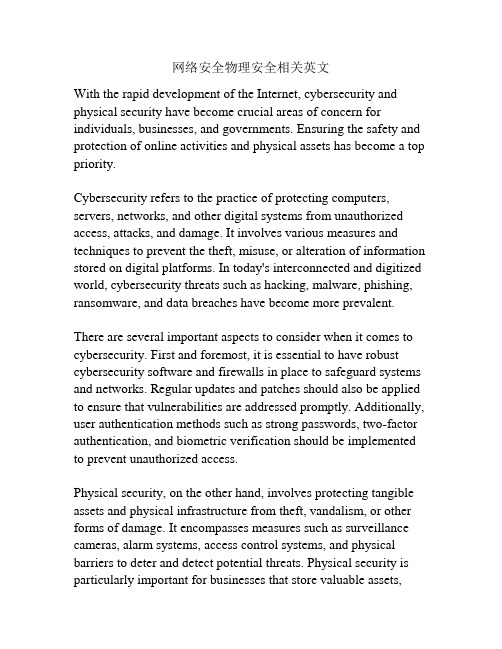
网络安全物理安全相关英文With the rapid development of the Internet, cybersecurity and physical security have become crucial areas of concern for individuals, businesses, and governments. Ensuring the safety and protection of online activities and physical assets has become a top priority.Cybersecurity refers to the practice of protecting computers, servers, networks, and other digital systems from unauthorized access, attacks, and damage. It involves various measures and techniques to prevent the theft, misuse, or alteration of information stored on digital platforms. In today's interconnected and digitized world, cybersecurity threats such as hacking, malware, phishing, ransomware, and data breaches have become more prevalent.There are several important aspects to consider when it comes to cybersecurity. First and foremost, it is essential to have robust cybersecurity software and firewalls in place to safeguard systems and networks. Regular updates and patches should also be applied to ensure that vulnerabilities are addressed promptly. Additionally, user authentication methods such as strong passwords, two-factor authentication, and biometric verification should be implemented to prevent unauthorized access.Physical security, on the other hand, involves protecting tangible assets and physical infrastructure from theft, vandalism, or other forms of damage. It encompasses measures such as surveillance cameras, alarm systems, access control systems, and physical barriers to deter and detect potential threats. Physical security is particularly important for businesses that store valuable assets,sensitive data, or confidential information. It also plays a crucial role in ensuring public safety in public places such as airports, train stations, and government buildings.Combining cybersecurity and physical security is essential to create a comprehensive and effective security strategy. An integrated approach ensures that both the digital and physical aspects of security are covered. For example, physical security measures can include securing servers and data centers, controlling access to computer rooms, and implementing strict protocols for data disposal. Likewise, cybersecurity measures can include monitoring and analyzing video surveillance footage, implementing intrusion detection systems, and conducting regular security audits.In conclusion, both cybersecurity and physical security are critical for safeguarding individuals, businesses, and governments from various threats. A robust and integrated security strategy that combines both aspects is necessary to effectively protect valuable assets, data, and systems. It is essential to continuously stay updated on the latest security trends, vulnerabilities, and best practices to mitigate risks and stay one step ahead of potential threats.。
通过网络非法入侵的英语作文

通过网络非法入侵的英语作文Cyber intrusion has become a rampant issue in today's digital age. Individuals and organizations alike are falling victim to malicious cyber attacks, resulting in stolen personal information, financial losses, and damaged reputations. 网络入侵已经成为当今数字时代的猖獗问题。
个人和组织都成为恶意网络攻击的受害者,导致个人信息被盗,财务损失,以及声誉受损。
One of the main challenges of combating cyber intrusion is the difficulty in tracing the perpetrators. With the anonymity provided by the internet, hackers can easily cover their tracks and evade detection by law enforcement agencies. This lack of accountability makes it easier for hackers to carry out their attacks without fear of consequences. 打击网络入侵的主要挑战之一是在追踪肇事者时的困难。
在互联网提供的匿名性下,黑客可以轻松地掩盖自己的踪迹,逃避执法机构的检测。
这种缺乏责任感使得黑客更容易在没有后果的情况下进行攻击。
Moreover, the rapid advancements in technology have made it easier for cyber criminals to exploit vulnerabilities in systems and networks. With the increasing connectivity of devices and the rise of theInternet of Things (IoT), there are more entry points for hackers to infiltrate and wreak havoc. This constant evolution of technology poses a significant challenge for cybersecurity professionals in staying ahead of cyber threats. 此外,技术的快速发展使得网络犯罪分子更容易利用系统和网络中的漏洞。
ACMTransactionsonCyber-PhysicalSystems
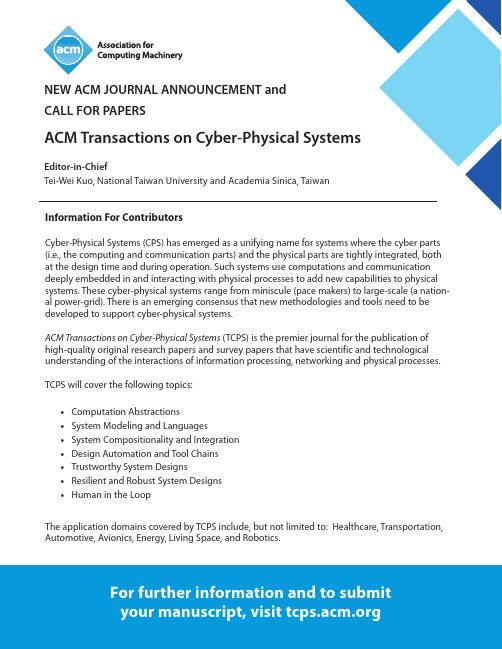
Information For ContributorsCyber-Physical Systems (CPS) has emerged as a unifying name for systems where the cyber parts (i.e., the computing and communication parts) and the physical parts are tightly integrated, both at the design time and during operation. Such systems use computations and communication deeply embedded in and interacting with physical processes to add new capabilities to physical systems. These cyber-physical systems range from miniscule (pace makers) to large-scale (a nation-al power-grid). There is an emerging consensus that new methodologies and tools need to be developed to support cyber-physical systems.ACM Transactions on Cyber-Physical Systems (TCPS) is the premier journal for the publication of high-quality original research papers and survey papers that have scientific and technological understanding of the interactions of information processing, networking and physical processes. TCPS will cover the following topics:• Computation Abstractions• System Modeling and Languages• System Compositionality and Integration• Design Automation and Tool Chains• Trustworthy System Designs• Resilient and Robust System Designs• Human in the LoopThe application domains covered by TCPS include, but not limited to: Healthcare, Transportation, Automotive, Avionics, Energy, Living Space, and Robotics.For further information and to submityour manuscript, visit Associate EditorsTarek Abdelzaher, University of Illinois at Urbana-Champaign, USA Karl-Erik Arzen, Lunds University, SwedenGiorgio C. Buttazzo, Scuola Superiore Sant'Anna, ItalyAnind Dey, Carnegie Mellon University, USAMarco Dorigo, Université Libre de Bruxelles, BelgiumShirley Dyke, Purdue University, USATom Fuhrman, GM, USAChris Gill, Washington University in St. Louis, USASteve Goddard, University of Nebraska-Lincoln, USAArne Hamann, Bosch, GermanyC. William Hanson, Hospital of the University of Pennsylvania, USAPi-Ching Hsiu, Academia Sinica, TaiwanJoerg Henkel, Karlsruhe Institute of Technology, GermanyX. Sharon Hu, University of Notre Dame, USAInsup Lee, University of Pennsylvania, USAChenyang Lu, Washington University in St. Louis, USAAloysius K. Mok,University of Texas and Awiatech Corporation, USA Ai-Chun Pang, National Taiwan University, TaiwanKrithi Ramamritham, IIT, IndiaRaj Rajkumar, Carnegie Mellon University, USAJoseph Sifakis, CNRS, France, and EPFL, SwitzerlandSandeep K. Shukla, Virginia Tech, USALui Sha, University of Illinois at Urbana-Champaign, USAZili Shao, Honk Kong Polytechnic University, ChinaSang Hyuk Son, DGIST, KoreaJack Stankovic, University of Virginia, USAJanos Sztipanovits, Vanderbilt University, USALothar Thiele, ETH, SwitzerlandHideyuki Tokuda, Keio Univeristy, JapanFeng Zhao, Microsoft Research Asia, ChinaEditorial Office Contact Information:Laura A. LanderACM Journals Manager2 Penn Plaza | New York, NY 10121Email:*************.org。
CyberPhysicalSystems_物理网络系统
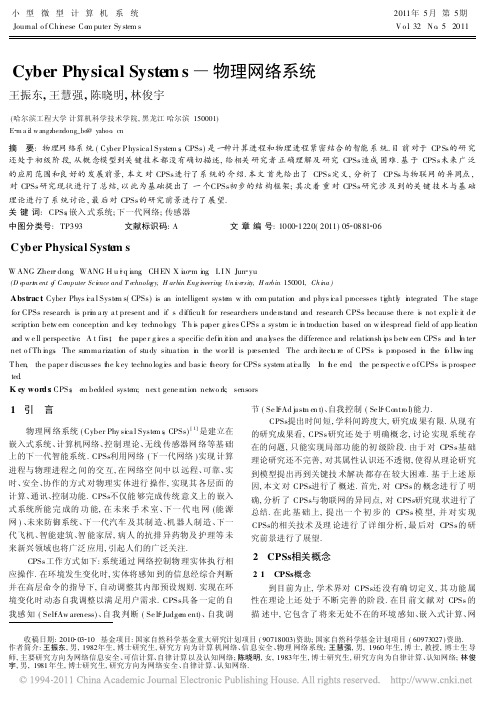
( 2) CPSs与物联网使用的关键技 术不同. 物联网使 用的 关键技术是 RF ID、传感器、智能 芯片、无线 网络. 物 联网利 用 射频自动识别技术, 通过计算机互 联网实现物 品 (商 品 ) 的自 动识别和 信息的互联与共享. CPSs使用的关键技术 为嵌入式 技术、网络技术、智能控 制技 术、传感 器技 术等 等. CPSs利 用 上述技术实现对物理 实体的控制.
2 CPSs相关概念
2. 1 CPSs概念 到目前为止, 学术界对 CPSs还 没有确 切定义, 其 功能 属
性在理论上还 处于 不断 完善 的阶 段. 在目 前文 献 对 CPSs 的 描 述中, 它包含了 将来无处不在的环境 感知、嵌 入式计算、网
收稿日期: 2010 03 10 基金项目: 国家自然科学基金重大研究计划项目 ( 90718003) 资助; 国家自然科学基金计划项目 ( 60973027 ) 资助. 作者简介: 王振东, 男, 1982年生, 博士研究生, 研究方 向为计算 机网络、信 息安全、物理 网络系统; 王慧强, 男, 1960 年生, 博 士, 教授, 博士生 导
物联网是通过射 频识 别 ( RF ID )、红外 感应 器、全球定 位 系统、激光扫描器等信息 传感设 备, 按 约定的 协议, 把任何 物 品与互联网连接起来, 进行信息交换和通讯, 以实现智能化识 别、定位、跟踪、监控和管理的一种网 络. 通 常的 RF ID 系 统包 括前端的射频终端和 后台的 计算机 信息管理 系统. 射频 终端 由读写器和标签组成 , 标签 用于存 储所标 识物品 的身份 和属 性的信息, 读写器作为信息采集终端, 利 用射频信号对标签进 行识别并与计算机信 息系统进行通信 [ 6].
cybersecurity英文解释
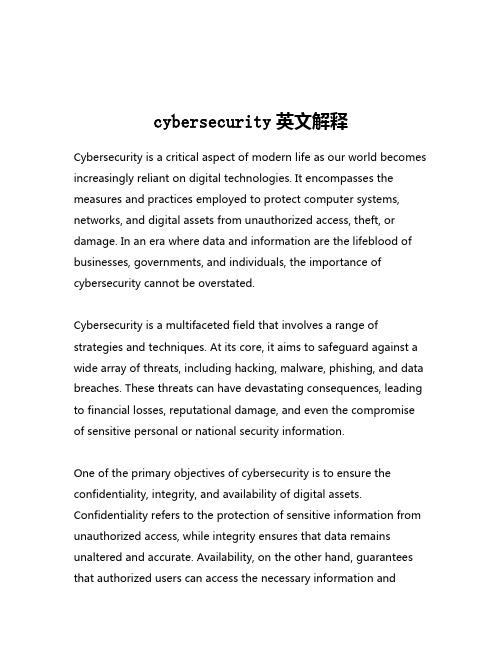
cybersecurity英文解释Cybersecurity is a critical aspect of modern life as our world becomes increasingly reliant on digital technologies. It encompasses the measures and practices employed to protect computer systems, networks, and digital assets from unauthorized access, theft, or damage. In an era where data and information are the lifeblood of businesses, governments, and individuals, the importance of cybersecurity cannot be overstated.Cybersecurity is a multifaceted field that involves a range of strategies and techniques. At its core, it aims to safeguard against a wide array of threats, including hacking, malware, phishing, and data breaches. These threats can have devastating consequences, leading to financial losses, reputational damage, and even the compromise of sensitive personal or national security information.One of the primary objectives of cybersecurity is to ensure the confidentiality, integrity, and availability of digital assets. Confidentiality refers to the protection of sensitive information from unauthorized access, while integrity ensures that data remains unaltered and accurate. Availability, on the other hand, guarantees that authorized users can access the necessary information andsystems when they need to.To achieve these objectives, cybersecurity professionals employ a range of tools and techniques. These include firewalls, antivirus software, encryption, access controls, and intrusion detection and prevention systems. Additionally, regular software updates, patch management, and employee training on cybersecurity best practices are crucial elements of a comprehensive cybersecurity strategy.In the face of an ever-evolving threat landscape, cybersecurity professionals must constantly adapt and stay ahead of the curve. Cybercriminals are becoming increasingly sophisticated, leveraging advanced technologies and exploiting vulnerabilities in systems and human behavior. Consequently, cybersecurity professionals must continuously monitor for new threats, analyze emerging trends, and implement robust countermeasures to protect against these evolving dangers.Beyond technical measures, cybersecurity also encompasses legal and regulatory frameworks. Governments and international organizations have developed a range of laws, regulations, and standards to govern the handling of digital information and the responsibilities of organizations in protecting it. Compliance with these frameworks is essential for businesses and institutions to mitigate the risks of data breaches and other cybersecurity incidents.The impact of cybersecurity extends far beyond the realm of technology. It has significant implications for national security, economic stability, and individual privacy. Cyberattacks can disrupt critical infrastructure, compromise sensitive government information, and even threaten the stability of financial markets. Consequently, cybersecurity has become a top priority for policymakers, business leaders, and citizens alike.To address the growing challenges of cybersecurity, a multifaceted approach is required. This includes investing in advanced technologies, fostering collaboration between the public and private sectors, and promoting cybersecurity education and awareness among the general population. By taking a proactive and comprehensive approach to cybersecurity, we can better safeguard our digital assets and ensure the resilience of our increasingly interconnected world.In conclusion, cybersecurity is a complex and ever-evolving field that is essential for the protection of our digital lives. As our reliance on technology continues to grow, the need for robust and adaptable cybersecurity measures has never been more pressing. By embracing a holistic approach to cybersecurity, we can work towards a future where our digital assets are secured, our privacy is protected, and our societies are resilient in the face of emerging cyber threats.。
网络安全的重要性英语作文

网络安全的重要性英语作文Cybersecurity is a crucial aspect of our modern society. 网络安全是现代社会的一个关键方面。
As we increasingly rely on the internet for communication, shopping, banking, and various other activities, the protection of our personal information is essential. 随着我们越来越依赖互联网进行沟通、购物、银行业务以及其他各种活动,保护我们的个人信息变得至关重要。
One of the main reasons why cybersecurity is so important is the prevalence of cyber attacks. 网络安全如此重要的一个主要原因是网络攻击的普遍性。
Hackers are constantly looking for vulnerabilities in systems to exploit, whether for financial gain, spying, or simply causing disruption. 黑客们不断寻找系统中的漏洞来实现利益,进行间谍活动或者仅仅是造成混乱。
Furthermore, the interconnected nature of the digital world means that a security breach in one place can have far-reaching consequences. 此外,数字世界的互相连接意味着一个地方的安全漏洞可能会产生深远的影响。
A breach in a critical infrastructure system, such as power grids or transportation networks, could lead to widespreaddisruption and potentially endanger lives. 一些关键基础设施系统的漏洞,比如电力网络或者交通网络,可能会导致广泛的破坏并有可能危及生命。
信息物理系统(cyber physical systems)及其对网络科学研究的影响
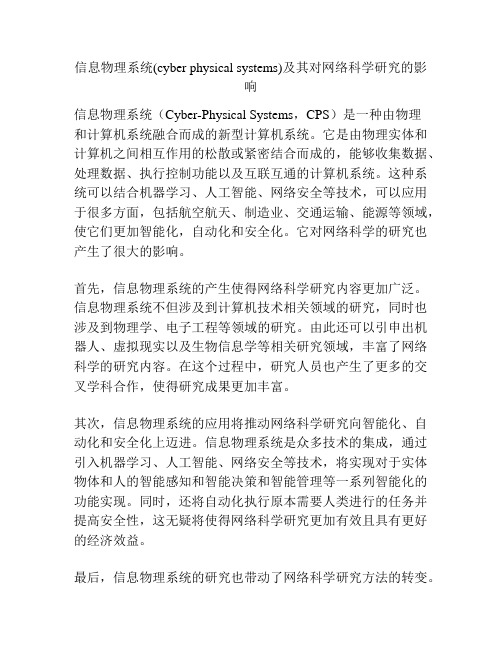
信息物理系统(cyber physical systems)及其对网络科学研究的影响信息物理系统(Cyber-Physical Systems,CPS)是一种由物理和计算机系统融合而成的新型计算机系统。
它是由物理实体和计算机之间相互作用的松散或紧密结合而成的,能够收集数据、处理数据、执行控制功能以及互联互通的计算机系统。
这种系统可以结合机器学习、人工智能、网络安全等技术,可以应用于很多方面,包括航空航天、制造业、交通运输、能源等领域,使它们更加智能化,自动化和安全化。
它对网络科学的研究也产生了很大的影响。
首先,信息物理系统的产生使得网络科学研究内容更加广泛。
信息物理系统不但涉及到计算机技术相关领域的研究,同时也涉及到物理学、电子工程等领域的研究。
由此还可以引申出机器人、虚拟现实以及生物信息学等相关研究领域,丰富了网络科学的研究内容。
在这个过程中,研究人员也产生了更多的交叉学科合作,使得研究成果更加丰富。
其次,信息物理系统的应用将推动网络科学研究向智能化、自动化和安全化上迈进。
信息物理系统是众多技术的集成,通过引入机器学习、人工智能、网络安全等技术,将实现对于实体物体和人的智能感知和智能决策和智能管理等一系列智能化的功能实现。
同时,还将自动化执行原本需要人类进行的任务并提高安全性,这无疑将使得网络科学研究更加有效且具有更好的经济效益。
最后,信息物理系统的研究也带动了网络科学研究方法的转变。
传统的网络科学关注于网络结构的建模与分析,而信息物理系统的研究则侧重于从物理模型、控制模型、人机交互等角度深入分析网络中的物理实体,并通过数据挖掘、机器学习等方法对网络数据进行建模和挖掘。
这种转变不仅丰富了网络科学的研究视角,也为网络科学的研究方法注入了新的活力。
总之,信息物理系统的产生和应用使得网络科学研究的领域更加广泛、向智能化、自动化和安全化方向上发展,以及研究方法也得到了转变。
信息物理系统对网络科学的研究带来了很大的影响,未来随着技术的不断进步,信息物理系统的应用将会在许多领域得到更广泛的应用。
英语网络安全演讲稿(3篇)

第1篇Ladies and Gentlemen,Good morning/afternoon/evening. It is an honor to stand before you today to discuss a topic that is increasingly becoming a critical aspect of our lives: cybersecurity. In this digital age, where technology has become an integral part of our daily routines, we are exposed to numerous risks and vulnerabilities that threaten our personal and professional lives. Therefore, it is essential that we understand the cybersecurity landscape and take appropriate measures to protect ourselves.Introduction----------------The digital revolution has transformed the way we live, work, and communicate. From smartphones to smart homes, from online banking to e-commerce, technology has brought about a world of convenience. However, with this convenience comes a host of cybersecurity challenges that we must address.What is Cybersecurity?----------------------Cybersecurity refers to the practices, technologies, and policies designed to protect systems, networks, and data from cyber threats. These threats can come in various forms, such as malware, phishing attacks, ransomware, and data breaches. Cybersecurity is crucial in ensuring the confidentiality, integrity, and availability of our digital assets.The Importance of Cybersecurity-------------------------------1. Personal Protection:Cybersecurity is essential for protecting our personal information, such as financial data, health records, and social security numbers. A single data breach can lead to identity theft, financial loss, and other serious consequences.2. Business Security:For businesses, cybersecurity is vital for protecting intellectual property, customer data, and financial information. A cyber attack can disrupt operations, damage reputation, and lead to significant financial losses.3. National Security:Cybersecurity is a critical component of national security. Attacks on critical infrastructure, such as power grids, transportation systems, and communication networks, can have far-reaching consequences for public safety and national interests.The Cybersecurity Landscape--------------------------1. The Rise of Cyber Threats:Over the past decade, the number of cyber threats has increased exponentially. Hackers and cybercriminals are becoming more sophisticated, using advanced techniques to exploit vulnerabilities in systems and networks.2. The Role of Cybersecurity Solutions:To combat these threats, organizations and individuals must invest in cybersecurity solutions, such as firewalls, antivirus software,intrusion detection systems, and security awareness training.3. The Human Factor:Despite the availability of advanced cybersecurity solutions, the human factor remains a significant vulnerability. Employees and users oftenfall victim to social engineering attacks, such as phishing emails and spear-phishing campaigns.Key Cybersecurity Best Practices-------------------------------1. Strong Passwords:Create strong, unique passwords for each of your online accounts. Use a combination of letters, numbers, and special characters to make your passwords more secure.2. Multi-Factor Authentication:Enable multi-factor authentication (MFA) on your accounts whenever possible. MFA adds an additional layer of security by requiring more than one method of verification to access an account.3. Regular Software Updates:Keep your operating systems, applications, and antivirus software up to date. Regular updates often include security patches that fix vulnerabilities exploited by cyber attackers.4. Secure Wi-Fi Networks:Use secure, encrypted Wi-Fi networks and avoid public Wi-Fi hotspots when accessing sensitive information. If you must use a public Wi-Fi network, consider using a virtual private network (VPN) to encrypt your data.5. Be Wary of Phishing Attacks:Be cautious of unsolicited emails, messages, and phone calls asking for personal information. Always verify the legitimacy of the sender before providing any sensitive data.6. Backup Your Data:Regularly backup your important data to an external hard drive, cloud storage, or another secure location. In the event of a cyber attack, having a recent backup can help you recover your data more quickly.7. Educate Yourself and Your Team:Stay informed about the latest cybersecurity threats and best practices. Educate yourself and your team on how to recognize and respond to potential cyber threats.Conclusion-----------In conclusion, cybersecurity is a critical concern in today's digital world. By understanding the cybersecurity landscape and implementing best practices, we can reduce our risk of falling victim to cyber threats. As individuals, businesses, and a nation, we must prioritize cybersecurity and work together to create a safer digital environment.Thank you for your attention, and I encourage you to take proactive steps to protect yourself and your digital assets. Remember, in thefight against cyber threats, we are all in this together.第2篇Ladies and Gentlemen,Good morning/afternoon. It is my great pleasure to stand before you today to address an issue that is increasingly becoming a part of our daily lives – cybersecurity. In this digital age, where technology has become an integral part of our lives, the importance of ensuring cybersecurity cannot be overstated. Today, I will discuss the significance of cybersecurity, the challenges we face, and the steps we can take to protect ourselves and our organizations from cyber threats.I. IntroductionThe digital revolution has brought about immense benefits, enabling us to communicate, access information, and conduct business at unprecedented speeds. However, this interconnected world has also madeus vulnerable to cyber threats. Cybersecurity is the practice of protecting systems, networks, and data from digital attacks. It is essential for individuals, businesses, and governments to understand the importance of cybersecurity and take appropriate measures to safeguard their digital assets.II. The Significance of Cybersecurity1. Protection of Personal InformationIn today's digital world, we share vast amounts of personal information online. This includes our financial details, health records, and evenour location. Cybersecurity ensures that this sensitive information remains secure and is not misused by malicious actors.2. Business ContinuityCybersecurity is crucial for businesses to maintain their operations and avoid financial losses. A cyber attack can disrupt business activities, damage reputation, and lead to significant financial losses.3. National SecurityCybersecurity is vital for protecting a nation's critical infrastructure, such as power grids, transportation systems, and communication networks.A successful cyber attack on these systems can have catastrophic consequences for public safety and national security.4. Trust and ConfidenceAs individuals and organizations become more aware of cyber threats, ensuring cybersecurity becomes essential for maintaining trust and confidence in digital platforms and services.III. Challenges in Cybersecurity1. Increasing ComplexityThe digital landscape is becoming increasingly complex, with new technologies and devices being introduced at a rapid pace. Thiscomplexity makes it challenging to keep up with the evolving nature of cyber threats.2. Sophisticated Attack TechniquesCyber attackers are continuously developing new and sophisticated techniques to bypass security measures. This requires cybersecurity professionals to stay updated with the latest trends and technologies.3. Human FactorHuman error is often the weakest link in cybersecurity. Employees may inadvertently fall victim to phishing attacks or fail to follow security protocols, leading to data breaches.4. Resource ConstraintsMany organizations, particularly small and medium-sized enterprises (SMEs), face resource constraints that limit their ability to invest in cybersecurity measures.IV. Steps to Enhance Cybersecurity1. Education and AwarenessThe first step towards enhancing cybersecurity is to educate individuals and organizations about the risks and best practices. This includes training employees on identifying and reporting potential threats.2. Strong Password PoliciesImplementing strong password policies, such as using complex passwords and multi-factor authentication, can significantly reduce the risk of unauthorized access.3. Regular Updates and Patch ManagementKeeping software and systems up to date with the latest security patches is crucial for preventing vulnerabilities that can be exploited by cyber attackers.4. Data EncryptionEncrypting sensitive data ensures that even if it is intercepted, it remains unreadable and secure.5. Network SecurityImplementing firewalls, intrusion detection systems, and other network security measures can help detect and prevent cyber attacks.6. Incident Response PlanningDeveloping an incident response plan can help organizations respond quickly and effectively to cyber attacks, minimizing damage and recovery time.7. Collaboration and Information SharingCollaboration between governments, businesses, and cybersecurity professionals is essential for sharing information and resources to combat cyber threats effectively.V. ConclusionIn conclusion, cybersecurity is a critical issue in the digital age. As technology continues to evolve, the importance of protecting our digital assets from cyber threats will only increase. By implementing the steps outlined in this presentation, individuals and organizations can enhance their cybersecurity posture and contribute to a safer and more secure digital world.Thank you for your attention, and I encourage you to take cybersecurity seriously in your personal and professional lives. Together, we can create a more secure and resilient digital environment for all.[End of speech]第3篇Ladies and Gentlemen,Good morning/afternoon/evening. It is my great pleasure to stand before you today to discuss a topic that is of paramount importance in our rapidly evolving digital age: cybersecurity. In this speech, I willexplore the significance of cybersecurity, the various threats that we face, and the steps we can take to ensure a secure digital world for all.The Digital Revolution and Its ImpactThe digital revolution has transformed our lives in countless ways. From the way we communicate to the way we conduct business, the internet has become an indispensable part of our daily routines. However, with this technological marvel comes a host of challenges, chief among them the need for robust cybersecurity measures.The Significance of CybersecurityCybersecurity is the practice of protecting computers, servers, mobile devices, electronic systems, networks, and data from malicious attacks. It is crucial for several reasons:1. Data Protection: In an era where data is king, the protection of sensitive information is paramount. Personal data, financial records, and corporate secrets are all at risk if not properly secured.2. Economic Security: Cyber attacks can lead to significant financial losses for individuals and organizations. Ransomware, phishing, and other cyber threats can disrupt business operations and lead to costly repairs.3. National Security: Cybersecurity is not just a concern for private entities; it is also a matter of national security. State-sponsored cyber attacks can compromise critical infrastructure, such as power grids and healthcare systems.4. Privacy: The internet has given us unprecedented access to information, but it has also raised concerns about privacy. Cybersecurity measures help ensure that our personal information remains private and secure.The Threat LandscapeThe cybersecurity landscape is constantly evolving, with new threats emerging almost daily. Some of the most common threats include:1. Malware: Malicious software designed to damage, disrupt, or gain unauthorized access to computer systems.2. Phishing: A fraudulent attempt to obtain sensitive information such as usernames, passwords, and credit card details by disguising oneself as a trustworthy entity.3. Ransomware: A type of malware that encrypts a victim's files, with the attacker demanding a ransom to restore access.4. DDoS Attacks: Distributed Denial of Service attacks aim to disrupt the normal functioning of a network or system by overwhelming it with traffic.5. Insider Threats: Employees or contractors with authorized access to systems who misuse their privileges for malicious purposes.Steps to Enhance CybersecurityTo combat these threats, it is essential to implement a comprehensive cybersecurity strategy. Here are some key steps that individuals and organizations can take:1. Education and Awareness: Educate yourself and your team about cybersecurity best practices. Regular training sessions can help reduce the risk of human error, which is often the weakest link in cybersecurity.2. Strong Passwords: Use strong, unique passwords for all accounts. Consider using a password manager to securely store and manage your passwords.3. Regular Updates: Keep your operating systems, software, and antivirus programs up to date to protect against known vulnerabilities.4. Backup and Recovery: Regularly backup your data and ensure that you have a robust recovery plan in place to minimize downtime in the event of a cyber attack.5. Secure Wi-Fi Networks: Use strong encryption and a unique SSID for your Wi-Fi network to prevent unauthorized access.6. Two-Factor Authentication: Enable two-factor authentication on all accounts that offer it to add an extra layer of security.7. Employee Monitoring: Implement monitoring systems to detect and respond to suspicious activity within your network.8. Incident Response Plan: Develop an incident response plan to ensure a coordinated and effective response to cyber attacks.The Role of Government and IndustryGovernment and industry play a critical role in shaping the cybersecurity landscape. Governments can:1. Enforce Regulations: Implement and enforce regulations that require organizations to adhere to cybersecurity standards.2. Invest in Research: Allocate funds for research and development of new cybersecurity technologies and strategies.3. International Collaboration: Collaborate with other countries to share intelligence and resources in the fight against cyber threats.Industry can:1. Set Standards: Develop and adopt industry standards for cybersecurity best practices.2. Innovate: Invest in the development of new technologies that can enhance cybersecurity.3. Transparency: Be transparent about security incidents and collaborate with authorities to address them effectively.ConclusionIn conclusion, cybersecurity is a complex and multifaceted challengethat requires a collective effort from individuals, organizations, and governments. As we continue to embrace the digital world, it is imperative that we prioritize cybersecurity to protect our data, our economy, and our national security.Let us all commit to staying vigilant, educating ourselves, and taking proactive steps to ensure a secure digital world for future generations. Thank you for your attention, and I look forward to any questions you may have.Thank you.。
cybersecurity 网络安全
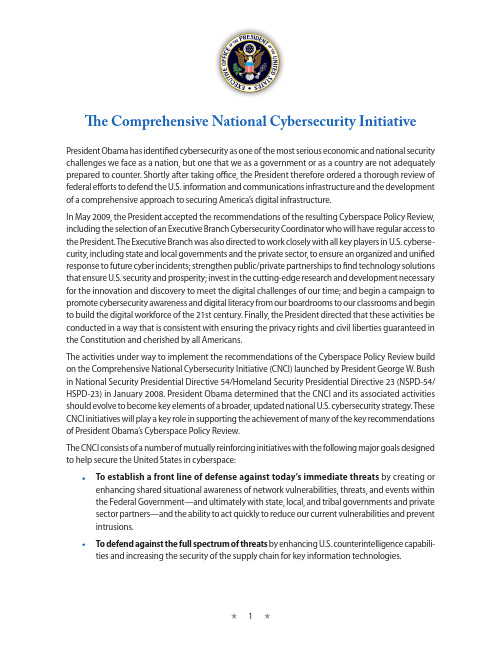
The Comprehensive National Cybersecurity Initiative President Obama has identified cybersecurity as one of the most serious economic and national security challenges we face as a nation, but one that we as a government or as a country are not adequately prepared to counter. Shortly after taking office, the President therefore ordered a thorough review of federal efforts to defend the U.S. information and communications infrastructure and the development of a comprehensive approach to securing America’s digital infrastructure.In May 2009, the President accepted the recommendations of the resulting Cyberspace Policy Review, including the selection of an Executive Branch Cybersecurity Coordinator who will have regular access to the President. The Executive Branch was also directed to work closely with all key players in U.S. cyberse-curity, including state and local governments and the private sector, to ensure an organized and unified response to future cyber incidents; strengthen public/private partnerships to find technology solutions that ensure U.S. security and prosperity; invest in the cutting-edge research and development necessary for the innovation and discovery to meet the digital challenges of our time; and begin a campaign to promote cybersecurity awareness and digital literacy from our boardrooms to our classrooms and begin to build the digital workforce of the 21st century. Finally, the President directed that these activities be conducted in a way that is consistent with ensuring the privacy rights and civil liberties guaranteed in the Constitution and cherished by all Americans.The activities under way to implement the recommendations of the Cyberspace Policy Review build on the Comprehensive National Cybersecurity Initiative (CNCI) launched by President George W. Bush in National Security Presidential Directive 54/Homeland Security Presidential Directive 23 (NSPD-54/ HSPD-23) in January 2008. President Obama determined that the CNCI and its associated activities should evolve to become key elements of a broader, updated national U.S. cybersecurity strategy. These CNCI initiatives will play a key role in supporting the achievement of many of the key recommendations of President Obama’s Cyberspace Policy Review.The CNCI consists of a number of mutually reinforcing initiatives with the following major goals designed to help secure the United States in cyberspace:••To•establish•a•front•line•of•defense•against•today’s•immediate•threats•by creating or enhancing shared situational awareness of network vulnerabilities, threats, and events within the Federal Government—and ultimately with state, local, and tribal governments and private sector partners—and the ability to act quickly to reduce our current vulnerabilities and prevent intrusions.••To•defend•against•the•full•spectrum•of•threats•by enhancing U.S. counterintelligence capabili-ties and increasing the security of the supply chain for key information technologies.••To•strengthen•the•future•cybersecurity•environment•by expanding cyber education; coordi-nating and redirecting research and development efforts across the Federal Government; and working to define and develop strategies to deter hostile or malicious activity in cyberspace. In building the plans for the CNCI, it was quickly realized that these goals could not be achieved without also strengthening certain key strategic foundational capabilities within the Government. Therefore, the CNCI includes funding within the federal law enforcement, intelligence, and defense communities to enhance such key functions as criminal investigation; intelligence collection, processing, and analysis; and information assurance critical to enabling national cybersecurity efforts.The CNCI was developed with great care and attention to privacy and civil liberties concerns in close consultation with privacy experts across the government. Protecting civil liberties and privacy rights remain fundamental objectives in the implementation of the CNCI.In accord with President Obama’s declared intent to make transparency a touchstone of his presidency, the Cyberspace Policy Review identified enhanced information sharing as a key component of effective cybersecurity. To improve public understanding of Federal efforts, the Cybersecurity Coordinator has directed the release of the following summary description of the CNCI. CNCI•Initiative•DetailsInitiative•#1.•Manage•the•Federal•Enterprise•Network•as•a•single•network•enterprise•with•Trusted•Internet•Connections.•The Trusted Internet Connections (TIC) initiative, headed by the Office of Management and Budget and the Department of Homeland Security, covers the consolidation of the Federal Government’s external access points (including those to the Internet). This consolidation will result in a common security solution which includes: facilitating the reduction of external access points, establishing baseline security capabilities; and, validating agency adherence to those security capabilities. Agencies participate in the TIC initiative either as TIC Access Providers (a limited number of agencies that operate their own capabilities) or by contracting with commercial Managed Trusted IP Service (MTIPS) providers through the GSA-managed NETWORX contract vehicle.Initiative•#2.•Deploy•an•intrusion•detection•system•of•sensors•across•the•Federal•enterprise.•Intrusion Detection Systems using passive sensors form a vital part of U.S. Government network defenses by identifying when unauthorized users attempt to gain access to those networks. DHS is deploying, as part of its EINSTEIN 2 activities, signature-based sensors capable of inspecting Internet traffic entering Federal systems for unauthorized accesses and malicious content. The EINSTEIN 2 capability enables analysis of network flow information to identify potential malicious activity while conducting automatic full packet inspection of traffic entering or exiting U.S. Government networks for malicious activity using signature-based intrusion detection technology. Associated with this investment in technology is a parallel investment in manpower with the expertise required to accomplish DHS’s expanded network security mission. EINSTEIN 2 is capable of alerting US-CERT in real time to the presence of malicious or potentially harmful activity in federal network traffic and provides correlation and visualization of the derived data. Due to the capabilities within EINSTEIN 2, US-CERT analysts have a greatly improved understanding of the network environment and an increased ability to address the weaknesses and vulnerabilities in Federal network security. As a result, US-CERT has greater situational awareness and canT h eComp reh ensivenaT i onalCyberseCuri T yi ni T iaT ivemore effectively develop and more readily share security relevant information with network defenders across the U.S. Government, as well as with security professionals in the private sector and the American public. The Department of Homeland Security’s Privacy Office has conducted and published a Privacy Impact Assessment for the EINSTEIN 2 program.Initiative•#3.•Pursue•deployment•of•intrusion•prevention•systems•across•the•Federal•enterprise.•This Initiative represents the next evolution of protection for civilian Departments and Agencies of the Federal Executive Branch. This approach, called EINSTEIN 3, will draw on commercial technology and specialized government technology to conduct real-time full packet inspection and threat-based decision-making on network traffic entering or leaving these Executive Branch networks. The goal of EINSTEIN 3 is to identify and characterize malicious network traffic to enhance cybersecurity analysis, situational awareness and security response. It will have the ability to automatically detect and respond appropriately to cyber threats before harm is done, providing an intrusion prevention system supporting dynamic defense. EINSTEIN 3 will assist DHS US-CERT in defending, protecting and reducing vulner-abilities on Federal Executive Branch networks and systems. The EINSTEIN 3 system will also support enhanced information sharing by US-CERT with Federal Departments and Agencies by giving DHS the ability to automate alerting of detected network intrusion attempts and, when deemed necessary by DHS, to send alerts that do not contain the content of communications to the National Security Agency (NSA) so that DHS efforts may be supported by NSA exercising its lawfully authorized missions. This initiative makes substantial and long-term investments to increase national intelligence capabilities to discover critical information about foreign cyber threats and use this insight to inform EINSTEIN 3 systems in real time. DHS will be able to adapt threat signatures determined by NSA in the course of its foreign intelligence and DoD information assurance missions for use in the EINSTEIN 3 system in support of DHS’s federal system security mission. Information sharing on cyber intrusions will be conducted in accordance with the laws and oversight for activities related to homeland security, intelligence, and defense in order to protect the privacy and rights of U.S. citizens.DHS is currently conducting a exercise to pilot the EINSTEIN 3 capabilities described in this initiative based on technology developed by NSA and to solidify processes for managing and protecting informa-tion gleaned from observed cyber intrusions against civilian Executive Branch systems. Government civil liberties and privacy officials are working closely with DHS and US-CERT to build appropriate and necessary privacy protections into the design and operational deployment of EINSTEIN 3. Initiative•#4:•Coordinate•and•redirect•research•and•development•(R&D)•efforts.•No single individual or organization is aware of all of the cyber-related R&D activities being funded by the Government. This initiative is developing strategies and structures for coordinating all cyber R&D sponsored or conducted by the U.S. government, both classified and unclassified, and to redirect that R&D where needed. This Initiative is critical to eliminate redundancies in federally funded cybersecurity research, and to identify research gaps, prioritize R&D efforts, and ensure the taxpayers are getting full value for their money as we shape our strategic investments.Initiative•#5.•Connect•current•cyber•ops•centers•to•enhance•situational•awareness. There is a pressing need to ensure that government information security offices and strategic operations centers share data regarding malicious activities against federal systems, consistent with privacy protectionsfor personally identifiable and other protected information and as legally appropriate, in order to have a better understanding of the entire threat to government systems and to take maximum advantage of each organization’s unique capabilities to produce the best overall national cyber defense possible. This initiative provides the key means necessary to enable and support shared situational awareness and collaboration across six centers that are responsible for carrying out U.S. cyber activities. This effort focuses on key aspects necessary to enable practical mission bridging across the elements of U.S. cyber activities: foundational capabilities and investments such as upgraded infrastructure, increased bandwidth, and integrated operational capabilities; enhanced collaboration, including common tech-nology, tools, and procedures; and enhanced shared situational awareness through shared analytic and collaborative technologies.The National Cybersecurity Center (NCSC) within the Department of Homeland Security will play a key role in securing U.S. Government networks and systems under this initiative by coordinating and integrating information from the six centers to provide cross-domain situational awareness, analyzing and reporting on the state of U.S. networks and systems, and fostering interagency collaboration and coordination.Initiative•#6.•Develop•and•implement•a•government-wide•cyber•counterintelligence•(CI)•plan.•A government-wide cyber counterintelligence plan is necessary to coordinate activities across all Federal Agencies to detect, deter, and mitigate the foreign-sponsored cyber intelligence threat to U.S. and private sector information systems. To accomplish these goals, the plan establishes and expands cyber CI education and awareness programs and workforce development to integrate CI into all cyber opera-tions and analysis, increase employee awareness of the cyber CI threat, and increase counterintelligence collaboration across the government. The Cyber CI Plan is aligned with the National Counterintelligence Strategy of the United States of America (2007) and supports the other programmatic elements of the CNCI. Initiative•#7.•Increase•the•security•of•our•classified•networks.•Classified networks house the Federal Government’s most sensitive information and enable crucial war-fighting, diplomatic, counterterrorism, law enforcement, intelligence, and homeland security operations. Successful penetration or disruption of these networks could cause exceptionally grave damage to our national security. We need to exercise due diligence in ensuring the integrity of these networks and the data they contain. Initiative•#8.•Expand•cyber•education. While billions of dollars are being spent on new technologies to secure the U.S. Government in cyberspace, it is the people with the right knowledge, skills, and abilities to implement those technologies who will determine success. However there are not enough cybersecurity experts within the Federal Government or private sector to implement the CNCI, nor is there an adequately established Federal cybersecurity career field. Existing cybersecurity training and personnel development programs, while good, are limited in focus and lack unity of effort. In order to effectively ensure our continued technical advantage and future cybersecurity, we must develop a technologically-skilled and cyber-savvy workforce and an effective pipeline of future employees. It will take a national strategy, similar to the effort to upgrade science and mathematics education in the 1950’s, to meet this challenge.Initiative•#9.•Define•and•develop•enduring•“leap-ahead”•technology,•strategies,•and•programs.•One goal of the CNCI is to develop technologies that provide increases in cybersecurity by orders of magnitude above current systems and which can be deployed within 5 to 10 years. This initiative seeksT h eComp reh ensivenaT i onalCyberseCuri T yi ni T iaT iveto develop strategies and programs to enhance the component of the government R&D portfolio that pursues high-risk/high-payoff solutions to critical cybersecurity problems. The Federal Government has begun to outline Grand Challenges for the research community to help solve these difficult problems that require ‘out of the box’ thinking. In dealing with the private sector, the government is identifying and communicating common needs that should drive mutual investment in key research areas. Initiative•#10.•Define•and•develop•enduring•deterrence•strategies•and•programs.•Our Nation’s senior policymakers must think through the long-range strategic options available to the United States in a world that depends on assuring the use of cyberspace. To date, the U.S. Government has been implementing traditional approaches to the cybersecurity problem—and these measures have not achieved the level of security needed. This Initiative is aimed at building an approach to cyber defense strategy that deters interference and attack in cyberspace by improving warning capabilities, articulat-ing roles for private sector and international partners, and developing appropriate responses for both state and non-state actors.Initiative•#11.•Develop•a•multi-pronged•approach•for•global•supply•chain•risk•management. Globalization of the commercial information and communications technology marketplace provides increased opportunities for those intent on harming the United States by penetrating the supply chain to gain unauthorized access to data, alter data, or interrupt communications. Risks stemming from both the domestic and globalized supply chain must be managed in a strategic and comprehensive way over the entire lifecycle of products, systems and services. Managing this risk will require a greater awareness of the threats, vulnerabilities, and consequences associated with acquisition decisions; the development and employment of tools and resources to technically and operationally mitigate risk across the lifecycle of products (from design through retirement); the development of new acquisition policies and practices that reflect the complex global marketplace; and partnership with industry to develop and adopt supply chain and risk management standards and best practices. This initiative will enhance Federal Government skills, policies, and processes to provide departments and agencies with a robust toolset to better manage and mitigate supply chain risk at levels commensurate with the criticality of, and risks to, their systems and networks.Initiative•#12.•Define•the•Federal•role•for•extending•cybersecurity•into•critical•infrastructure•domains.•The U.S. Government depends on a variety of privately owned and operated critical infra-structures to carry out the public’s business. In turn, these critical infrastructures rely on the efficient operation of information systems and networks that are vulnerable to malicious cyber threats. This Initiative builds on the existing and ongoing partnership between the Federal Government and the public and private sector owners and operators of Critical Infrastructure and Key Resources (CIKR). The Department of Homeland Security and its private-sector partners have developed a plan of shared action with an aggressive series of milestones and activities. It includes both short-term and long-term recommendations, specifically incorporating and leveraging previous accomplishments and activities that are already underway. It addresses security and information assurance efforts across the cyber infrastructure to increase resiliency and operational capabilities throughout the CIKR sectors. It includes a focus on public-private sharing of information regarding cyber threats and incidents in both govern-ment and CIKR.。
cyber-physicalsystemssecurity
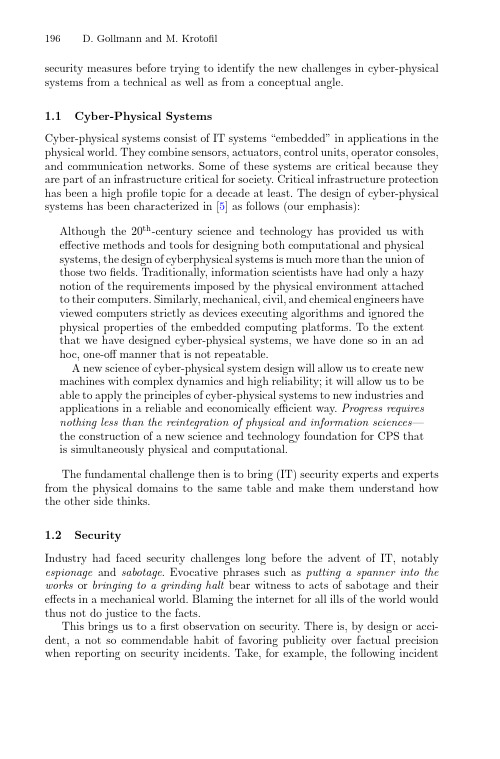
196 D.Gollmann and M.Krotofilsecurity measures before trying to identify the new challenges in cyber-physical systems from a technical as well as from a conceptual angle.1.1Cyber-Physical SystemsCyber-physical systems consist of IT systems“embedded”in applications in the physical world.They combine sensors,actuators,control units,operator consoles, and communication networks.Some of these systems are critical because they are part of an infrastructure critical for society.Critical infrastructure protection has been a high profile topic for a decade at least.The design of cyber-physical systems has been characterized in[5]as follows(our emphasis): Although the20th-century science and technology has provided us with effective methods and tools for designing both computational and physical systems,the design of cyberphysical systems is much more than the union of those twofields.Traditionally,information scientists have had only a hazy notion of the requirements imposed by the physical environment attached to their computers.Similarly,mechanical,civil,and chemical engineers have viewed computers strictly as devices executing algorithms and ignored the physical properties of the embedded computing platforms.To the extent that we have designed cyber-physical systems,we have done so in an ad hoc,one-offmanner that is not repeatable.A new science of cyber-physical system design will allow us to create newmachines with complex dynamics and high reliability;it will allow us to be able to apply the principles of cyber-physical systems to new industries and applications in a reliable and economically efficient way.Progress requires nothing less than the reintegration of physical and information sciences—the construction of a new science and technology foundation for CPS that is simultaneously physical and computational.The fundamental challenge then is to bring(IT)security experts and experts from the physical domains to the same table and make them understand how the other side thinks.1.2SecurityIndustry had faced security challenges long before the advent of IT,notably espionage and sabotage.Evocative phrases such as putting a spanner into the works or bringing to a grinding halt bear witness to acts of sabotage and their effects in a mechanical world.Blaming the internet for all ills of the world would thus not do justice to the facts.This brings us to afirst observation on security.There is,by design or acci-dent,a not so commendable habit of favoring publicity over factual precision when reporting on security incidents.Take,for example,the following incidentCyber-Physical Systems SecurityDieter Gollmann(B)and Marina KrotofilSecurity in Distributed Applications,Hamburg University of Technology,Hamburg,Germany{diego,Marina.Krotofil}@tuhh.deAbstract.We argue that cyber-physical systems cannot be protectedjust by protecting their IT infrastructure and that the CIA approach tosecurity is insufficient.Rather,the IT components should be treated asa control system,inputs to that control system should be checked forveracity,and control algorithms should be designed in a way that theycan handle a certain amount of adversarial actions.Keywords:Cyber-physical systems security·Integrity·Plausibilityveracity·Safety·Hard real time1IntroductionCyber-physical systems were mapped as a research area in a series of NFS work-shops starting from2006.Lee’s position paper at the inaugurating event already observed that in thisfield timing precision and security issues loom large[13]. Cyber-physical systems,by their very nature,cause effects in the physical world. In some cases,e.g.aircrafts,chemical plants,nuclear facilities,medical devices, or critical infrastructures in general,malfunction of a system can have disastrous physical consequences.On one hand,this is an issue that had to be dealt with already before physical systems were connected to cyberspace.Well-designed systems would have been deployed with appropriate safety measures in place. Conceivably,those measures can restrain cyber-physical attacks once they have transited from cyberspace into the physical domain.On the other hand,those countermeasures were designed under certain assumptions,e.g.physical security protecting access to premises or independence of component failures.Conceiv-ably,those assumptions get invalidated once modern IT systems get integrated with existing physical plants.Integrating modern IT systems with existing physical systems exposes those installations to new security threats.Some of these threats are well-known in IT security and countermeasures have been studied at length.Those threats are new only because of a new application area.Other threats may indeed be specific to cyber-physical systems.This paper aims at making a distinction between“old”attacks in new settings,and new attacks intrinsic to cyber-physical systems that would establish cyber-physical security as an object of study in its own rights.We will start with a brief introduction to cyber-physical systems and some general remarks on security.We will then explore the limitations of traditional c Springer-Verlag Berlin Heidelberg2016P.Y.A.Ryan et al.(Eds.):Kahn Festschrift,LNCS9100,pp.195–204,2016.DOI:10.1007/978-3-662-49301-414。
网络安全危害英语作文
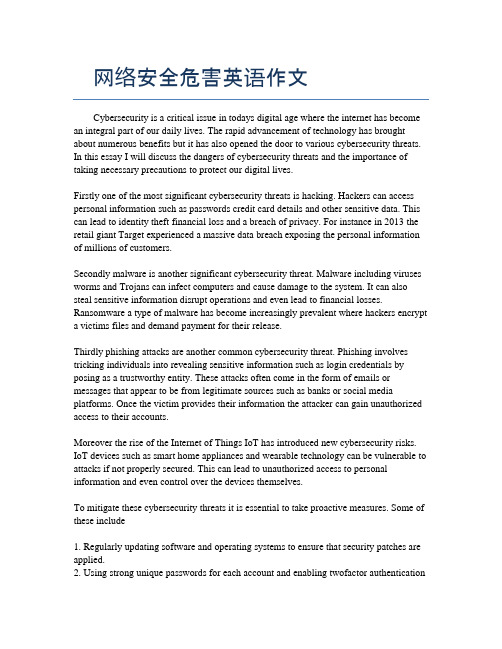
网络安全危害英语作文Cybersecurity is a critical issue in todays digital age where the internet has become an integral part of our daily lives. The rapid advancement of technology has brought about numerous benefits but it has also opened the door to various cybersecurity threats. In this essay I will discuss the dangers of cybersecurity threats and the importance of taking necessary precautions to protect our digital lives.Firstly one of the most significant cybersecurity threats is hacking. Hackers can access personal information such as passwords credit card details and other sensitive data. This can lead to identity theft financial loss and a breach of privacy. For instance in 2013 the retail giant Target experienced a massive data breach exposing the personal information of millions of customers.Secondly malware is another significant cybersecurity threat. Malware including viruses worms and Trojans can infect computers and cause damage to the system. It can also steal sensitive information disrupt operations and even lead to financial losses. Ransomware a type of malware has become increasingly prevalent where hackers encrypt a victims files and demand payment for their release.Thirdly phishing attacks are another common cybersecurity threat. Phishing involves tricking individuals into revealing sensitive information such as login credentials by posing as a trustworthy entity. These attacks often come in the form of emails or messages that appear to be from legitimate sources such as banks or social media platforms. Once the victim provides their information the attacker can gain unauthorized access to their accounts.Moreover the rise of the Internet of Things IoT has introduced new cybersecurity risks. IoT devices such as smart home appliances and wearable technology can be vulnerable to attacks if not properly secured. This can lead to unauthorized access to personal information and even control over the devices themselves.To mitigate these cybersecurity threats it is essential to take proactive measures. Some of these include1. Regularly updating software and operating systems to ensure that security patches are applied.2. Using strong unique passwords for each account and enabling twofactor authenticationwhere possible.3. Being cautious of unsolicited emails and messages and not clicking on suspicious links or attachments.4. Installing and maintaining reliable antivirus software to detect and remove malware.5. Educating oneself about cybersecurity best practices and staying informed about the latest threats.In conclusion cybersecurity threats are a significant concern in the digital world. By understanding the risks and taking appropriate precautions individuals and organizations can protect themselves from the dangers of cyber attacks. It is crucial to remain vigilant and prioritize cybersecurity to ensure the safety and integrity of our digital lives.。
cyber security英语作文

cyber security英语作文As the number of internet users continues to grow worldwide,internet safety is a growingconcern for both children and adults. The internet safety, or online safety, is the knowledge ofmaximizing the user's personal safety and security risks on private information and propertyassociated with using the internet, and the self-protection from computer crime in general.To begin with, we have to take the information security into consideration. As we allknow, sensitive information such as personal information and identity, passwords are oftenassociated with personal property (for example, bank accounts) and privacy and may presentsecurity concerns if leaked. Unauthorized access and usage of private information may resultin consequence such as identity theft, as well as theft of property.What's more, the personal safety cannot be ignored. The growth of the internet gave riseto many important services accessible to anyone with a connection. One of these importantservices is digital communication. While this service allowed us to communicate with othersthrough the internet, this also allowed the communication with malicious users. Whilemalicious users often use the internet for personal gain, this may not be limited tofinancial/material gain. This is especially a concern to parents and children, as children areoften targets of these malicious users.How can we deal with the problems in the Internet safety? Actually, we have severalpreventions. First, keeping shared information at a minimum and safe passwords and PiNs areuseful. Moreover, we'd better strengthen our Social network websites and security software.Through the use of antivirus software, the user can automatically detect, prevent andremove computer viruses and various types of malware. V ery often it is impossible for theuser alone to identify infected files and software until it is too late, especially if the infectedfile or software is well disguised as legitimate files. Because of this, it is important that theuser keeps antivirus software running on the computer whenever accessing the internet sothat the user can filter and block infected files and firewalls.。
Cyber-Physical Systems Security
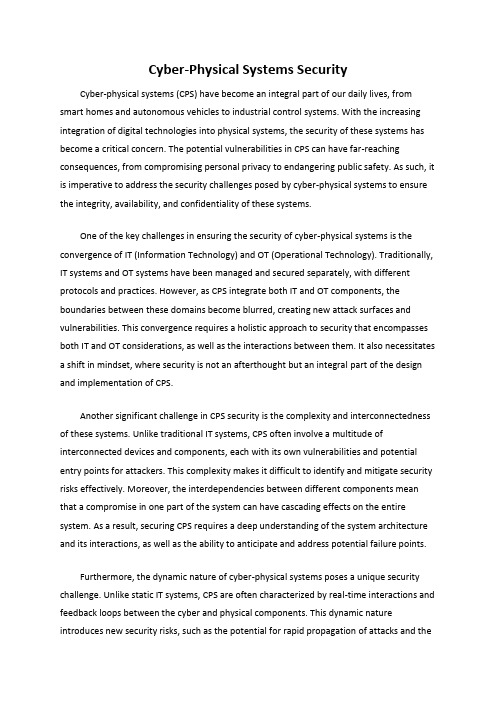
Cyber-Physical Systems SecurityCyber-physical systems (CPS) have become an integral part of our daily lives, from smart homes and autonomous vehicles to industrial control systems. With the increasing integration of digital technologies into physical systems, the security of these systems has become a critical concern. The potential vulnerabilities in CPS can have far-reaching consequences, from compromising personal privacy to endangering public safety. As such, it is imperative to address the security challenges posed by cyber-physical systems to ensure the integrity, availability, and confidentiality of these systems.One of the key challenges in ensuring the security of cyber-physical systems is the convergence of IT (Information Technology) and OT (Operational Technology). Traditionally, IT systems and OT systems have been managed and secured separately, with different protocols and practices. However, as CPS integrate both IT and OT components, the boundaries between these domains become blurred, creating new attack surfaces and vulnerabilities. This convergence requires a holistic approach to security that encompasses both IT and OT considerations, as well as the interactions between them. It also necessitates a shift in mindset, where security is not an afterthought but an integral part of the design and implementation of CPS.Another significant challenge in CPS security is the complexity and interconnectedness of these systems. Unlike traditional IT systems, CPS often involve a multitude of interconnected devices and components, each with its own vulnerabilities and potential entry points for attackers. This complexity makes it difficult to identify and mitigate security risks effectively. Moreover, the interdependencies between different components mean that a compromise in one part of the system can have cascading effects on the entire system. As a result, securing CPS requires a deep understanding of the system architecture and its interactions, as well as the ability to anticipate and address potential failure points.Furthermore, the dynamic nature of cyber-physical systems poses a unique security challenge. Unlike static IT systems, CPS are often characterized by real-time interactions and feedback loops between the cyber and physical components. This dynamic nature introduces new security risks, such as the potential for rapid propagation of attacks and theneed for real-time threat detection and response. Additionally, the increasing use of AI and machine learning in CPS introduces new security considerations, as these technologies can be vulnerable to adversarial attacks and manipulation. Addressing these challenges requires a proactive and adaptive approach to security, one that can keep pace with the evolving nature of CPS and the threats they face.In addition to technical challenges, the human factor is also a critical aspect of CPS security. Human errors and malicious insider threats can pose significant risks to the security of cyber-physical systems. Whether it is an employee inadvertently clicking on a phishing email or a disgruntled insider intentionally sabotaging the system, human actions can have profound implications for CPS security. This highlights the importance of not only technical safeguards but also robust security awareness and training programs for personnel involved in the design, implementation, and operation of CPS. Furthermore, the increasing reliance on third-party vendors and suppliers in the CPS supply chain introduces additional human-related security risks, as the actions of these external parties can impact the overall security posture of CPS.Moreover, the increasing connectivity of cyber-physical systems to external networks and the internet amplifies the security risks. While connectivity brings numerous benefits, such as remote monitoring and control, it also expands the attack surface for potential adversaries. The exposure of CPS to the internet increases the likelihood of remote exploitation and cyberattacks, posing a significant threat to the security and safety of these systems. Securing internet-connected CPS requires robust perimeter defenses, secure communication protocols, and continuous monitoring and threat intelligence to detect and respond to potential attacks. It also necessitates a shift towards a security-by-design approach, where security considerations are integrated into the entire lifecycle of CPS, from design and development to deployment and maintenance.In conclusion, addressing the security challenges of cyber-physical systems requires a multifaceted approach that encompasses technical, human, and strategic considerations. From the convergence of IT and OT to the complexity and interconnectedness of CPS, as well as the dynamic nature of these systems and the human factor, there are numerouschallenges that must be addressed to ensure the security and resilience of cyber-physical systems. By adopting a holistic and proactive approach to security, integrating security into the design and operation of CPS, and fostering a security-aware culture, we can mitigate the risks and vulnerabilities associated with cyber-physical systems, ensuring the reliability and safety of these critical systems.。
[英语作文]Cybersecurity网络安全
![[英语作文]Cybersecurity网络安全](https://img.taocdn.com/s3/m/7cfae12d26284b73f242336c1eb91a37f0113272.png)
[英语作文]Cybersecurity网络安全Title: Navigating the Digital Frontier: The Imperative of CybersecurityIn an era where the internet has become an integral part of our daily lives, cybersecurity has emerged as a paramount concern. As we increasingly rely on technology for communication, business operations, and data storage, the vulnerabilities and risks associated with cyber threats have also grown exponentially. Cybersecurity refers to the measures and practices designed to protect computers, servers, mobile devices, electronic systems, and networks from malicious attacks, data breaches, and other forms of unauthorized access or damage.The importance of cybersecurity cannot be overstated. The consequences of security breaches can be catastrophic, ranging from financial loss and identity theft to national security threats and disruptions in critical infrastructure. In the digital age, information is power, and protecting that information is crucial to maintaining individual privacy, corporate competitiveness, and societal stability.There are various types of cyber threats that individuals and organizations must guard against. These include:1. Malware: Software designed to harm or secretly gain access to a computer system, such as viruses, worms, trojan horses, and spyware.2. Phishing: A social engineering tactic used to trick people into revealing sensitive information, often through fraudulent emails or websites.3. Hacking: Unauthorized access to a computer system with the intent to steal, modify, or destroy data.4. Denial-of-Service (DoS) Attacks: Overwhelming a system with traffic or requests to make it unavailable to users.5. Ransomware: A type of malware that holds a system's data hostage untila ransom is paid.6. SQL Injection: Attacking vulnerable databases to manipulate or steal data.7. Insider Threats: Compromises originating from within an organization by disgruntled employees or those with ill intent.To combat these threats, it is essential to implement a multi-layered approach to cybersecurity that includes the following strategies:1. Continuous Education and Awareness: Educating users about potential threats and how to identify and respond to them is fundamental in preventing security breaches.2. Strong Authentication: Implementing robust password protocols and multi-factor authentication to verify user identities.3. Regular Software Updates and Patches: Keeping software up-to-date helps to close security gaps exploited by hackers.4. Data Encryption: Encrypting sensitive data to protect it from being read or intercepted by unauthorized parties.5. Firewalls and Antivirus Software: Using firewalls and antivirus software to prevent, detect, and remove malware.6. Network Security: Securing networks with advanced technologies like intrusion detection and prevention systems.7. Incident Response Planning: Having a plan in place to manage and mitigate the impact of a security incident when it occurs.8. Regulatory Compliance: Adhering to relevant laws and standards that govern data protection and privacy.9. Cloud Security: Ensuring that cloud-based services and storage are secure and comply with established security frameworks.10. Risk Assessment and Management: Regularly assessing potential risks and implementing measures to manage and reduce them.Cybersecurity is not a one-time fix; it requires ongoing vigilance and adaptation to the ever-evolving threat landscape. As technology advances, so do the methods of cybercriminals. Therefore, staying informed about the latest trends in cyber threats and updates in cybersecurity measures is crucial for both individuals and organizations alike.In conclusion, cybersecurity is a complex and critical issue that affects every aspect of modern life. It demands a proactive and comprehensive approach to ensure the safety of our digital assets. By prioritizing cybersecurity, wecan better protect our personal information, safeguard our businesses, and maintain the integrity of our society's digital infrastructure. Let us commit to fostering a culture of cyber awareness and resilience to navigate the challenges of the digital frontier securely and confidently.。
信息物理系统攻击与检测研究综述
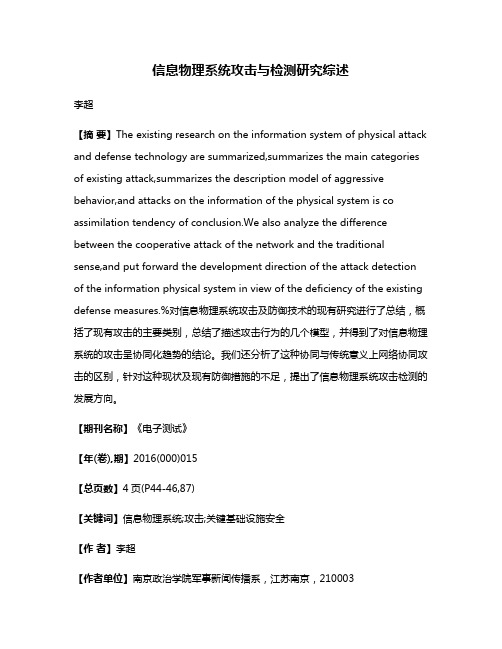
信息物理系统攻击与检测研究综述李超【摘要】The existing research on the information system of physical attack and defense technology are summarized,summarizes the main categories of existing attack,summarizes the description model of aggressive behavior,and attacks on the information of the physical system is co assimilation tendency of conclusion.We also analyze the difference between the cooperative attack of the network and the traditional sense,and put forward the development direction of the attack detection of the information physical system in view of the deficiency of the existing defense measures.%对信息物理系统攻击及防御技术的现有研究进行了总结,概括了现有攻击的主要类别,总结了描述攻击行为的几个模型,并得到了对信息物理系统的攻击呈协同化趋势的结论。
我们还分析了这种协同与传统意义上网络协同攻击的区别,针对这种现状及现有防御措施的不足,提出了信息物理系统攻击检测的发展方向。
【期刊名称】《电子测试》【年(卷),期】2016(000)015【总页数】4页(P44-46,87)【关键词】信息物理系统;攻击;关键基础设施安全【作者】李超【作者单位】南京政治学院军事新闻传播系,江苏南京,210003【正文语种】中文关键基础设施包括电力、交通、燃气等,是一个国家稳定和发展的基本支撑。
网络安全的重要性英语作文
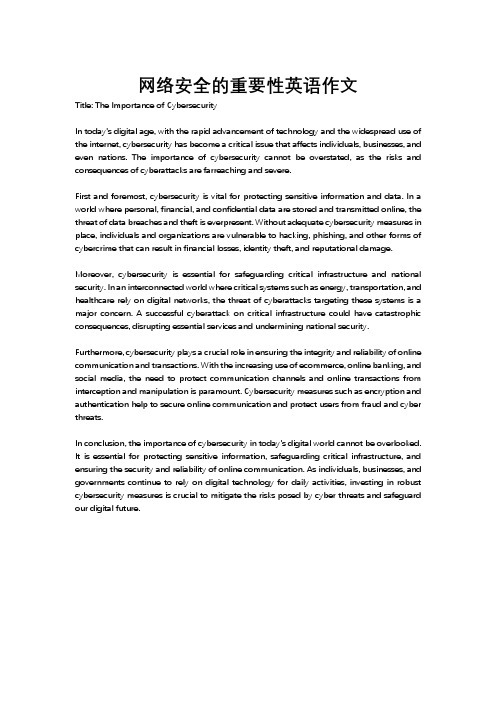
网络安全的重要性英语作文Title: The Importance of CybersecurityIn today's digital age, with the rapid advancement of technology and the widespread use of the internet, cybersecurity has become a critical issue that affects individuals, businesses, and even nations. The importance of cybersecurity cannot be overstated, as the risks and consequences of cyberattacks are farreaching and severe.First and foremost, cybersecurity is vital for protecting sensitive information and data. In a world where personal, financial, and confidential data are stored and transmitted online, the threat of data breaches and theft is everpresent. Without adequate cybersecurity measures in place, individuals and organizations are vulnerable to hacking, phishing, and other forms of cybercrime that can result in financial losses, identity theft, and reputational damage.Moreover, cybersecurity is essential for safeguarding critical infrastructure and national security. In an interconnected world where critical systems such as energy, transportation, and healthcare rely on digital networks, the threat of cyberattacks targeting these systems is a major concern. A successful cyberattack on critical infrastructure could have catastrophic consequences, disrupting essential services and undermining national security.Furthermore, cybersecurity plays a crucial role in ensuring the integrity and reliability of online communication and transactions. With the increasing use of ecommerce, online banking, and social media, the need to protect communication channels and online transactions from interception and manipulation is paramount. Cybersecurity measures such as encryption and authentication help to secure online communication and protect users from fraud and cyber threats.In conclusion, the importance of cybersecurity in today's digital world cannot be overlooked. It is essential for protecting sensitive information, safeguarding critical infrastructure, and ensuring the security and reliability of online communication. As individuals, businesses, and governments continue to rely on digital technology for daily activities, investing in robust cybersecurity measures is crucial to mitigate the risks posed by cyber threats and safeguard our digital future.。
关于安全的英语美文带翻译
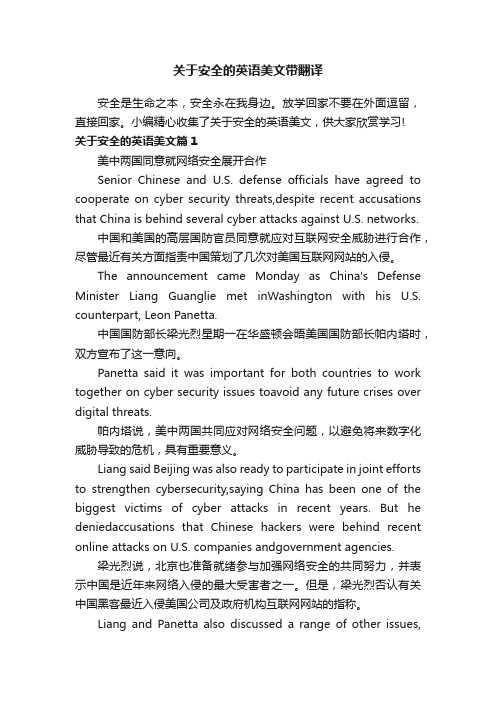
关于安全的英语美文带翻译安全是生命之本,安全永在我身边。
放学回家不要在外面逗留,直接回家。
小编精心收集了关于安全的英语美文,供大家欣赏学习!关于安全的英语美文篇1美中两国同意就网络安全展开合作Senior Chinese and U.S. defense officials have agreed to cooperate on cyber security threats,despite recent accusations that China is behind several cyber attacks against U.S. networks.中国和美国的高层国防官员同意就应对互联网安全威胁进行合作,尽管最近有关方面指责中国策划了几次对美国互联网网站的入侵。
The announcement came Monday as China's Defense Minister Liang Guanglie met inWashington with his U.S. counterpart, Leon Panetta.中国国防部长梁光烈星期一在华盛顿会晤美国国防部长帕内塔时,双方宣布了这一意向。
Panetta said it was important for both countries to work together on cyber security issues toavoid any future crises over digital threats.帕内塔说,美中两国共同应对网络安全问题,以避免将来数字化威胁导致的危机,具有重要意义。
Liang said Beijing was also ready to participate in joint efforts to strengthen cybersecurity,saying China has been one of the biggest victims of cyber attacks in recent years. But he deniedaccusations that Chinese hackers were behind recent online attacks on U.S. companies andgovernment agencies.梁光烈说,北京也准备就绪参与加强网络安全的共同努力,并表示中国是近年来网络入侵的最大受害者之一。
- 1、下载文档前请自行甄别文档内容的完整性,平台不提供额外的编辑、内容补充、找答案等附加服务。
- 2、"仅部分预览"的文档,不可在线预览部分如存在完整性等问题,可反馈申请退款(可完整预览的文档不适用该条件!)。
- 3、如文档侵犯您的权益,请联系客服反馈,我们会尽快为您处理(人工客服工作时间:9:00-18:30)。
1
Cyber-Physical Security in a Substation
Junho Hong∗,Alexandru Stefanov†,Chen-Ching Liu∗†,Manimaran Govindarasu‡
∗Washington State University
†University College,Dublin
‡Iowa State University
Abstract—New technologies including microprocessor-based Intelligent Electronic Devices(IEDs)and standardized protocol and TCP/IP over wide area networks(W AN)are well-adopted in the substations.Remote access to IEDs or user interfaces in a substation for maintenance purposes is a common practice. However,there are potential cyber-physical system vulnerabilities in a substation, e.g.,unsecured standard protocols,remote controllable IEDs,and unauthorized remote access to substation IEDs.In addition,some substation IEDs and user interfaces have a web server and hence it may provide a remote configuration change and control with default passwords.Even iffirewalls and cryptography schemes are used for cyber security,weak security key management cryptography and mis-configuredfirewalls are still exposed to intruders.From IT point of view,cyber security issues are well known and new security technologies are available. However,security research on the integration of IT and physical power systems for critical infrastructures is still an emerging area.
Intruders behaviors will generate logs across all substation-level networks, e.g.,IEDs,firewalls and user interfaces.For instance,the steps of Stuxnet attack are based on:(1)intrusion attempts,(2)change of thefile system,(3)change of target sys-tems setting,and(4)change of target systems status.Therefore, anomaly detection is performed based on logs of intruders foot prints.Temporal anomaly can be determined from discrepancies between event logs from two different time periods.In the proposed anomaly index,a value of0implies no difference, whereas1indicates the maximal discrepancy[1].
In order to identify the impact of substation cyber intrusion to the power grid,cyber intrusion scenarios have been conducted on the substation IT network using a SCADA testbed at University College Dublin(UCD).Thefirst intrusion scenario involves compromised substation gateway.A false signal is generated and an open circuit breaker(CB)command is sent to substation CBs.The second scenario is to generate forged CB status at the gateway.As a result of this attack,control center operators will observe fake data about the CB status.
However,the actual substation CBs status has not changed. The third scenario is to generate fabricated analogue values to a control center using a man-in-the-middle attack.Once an intruder successfully compromises the substation LAN,(s)he is able to monitor and capture all measured data which comes from power grids.If attackers send fabricated data to the control center and the data travel through the state estimationfilter, control center operators will observe an operational emergency. As a result,the operators may take emergency control actions such as reducing the generation voltage or reactive power while the power system is actually in a normal condition.There is a possibility these(logical)actions based on fabricated data will drive the system into a sequence of cascading events,leading to a power outage.
Mitigation actions are conducted on substation IT and power grid.For IT mitigation,intrusion detection system(IDS)which uses anomaly detection algorithm based on temporal event construction has been used in a substation network.An Optimal Power Flow(OPF)algorithm with an objective function that minimizes load shedding in the grid is used for power system mitigation.The proposed collaboration scheme between IDS and thefirewall is able to disconnect intruders in the substation network.Emergency control actions are taken to mitigate the effects of cyber intrusions as an attempt to restore a system back to a normal condition.
R EFERENCES
[1] C.-W.Ten,J.Hong and C. C.Liu,“Anomaly detection for cyber
security of the substations.”in Accepted for publication in IEEE Trans.
on Smart Grid.
978-1-4673-2729-9/12/$31.00 ©2012 IEEE。
